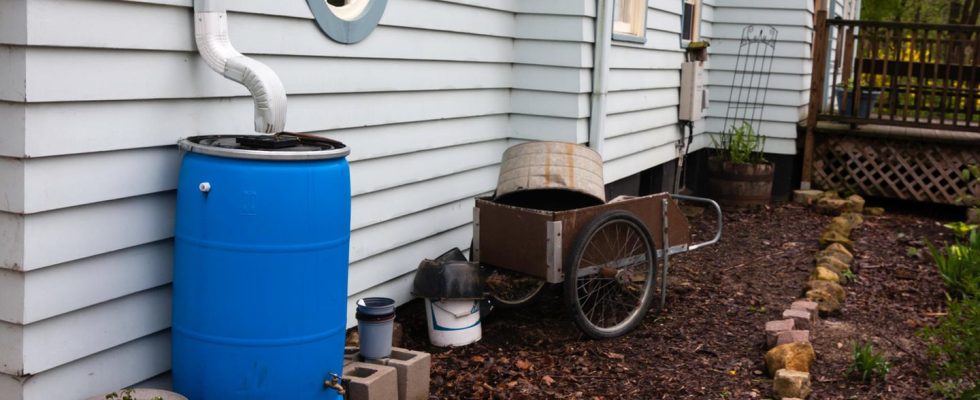Sub-zero temperatures
Rain barrels made of plastic, wood or metal: Which material is frost-proof?
When temperatures drop, the water in the rain barrel freezes
© patty_c / Getty Images
When temperatures drop below zero degrees, the water in the rain barrels freezes and expands. To prevent small cracks from forming in the material, the storage tank is winterized and emptied. But is that really necessary?
Many manufacturers advertise that their rain barrels are frost-proof. What many people don’t know, however, is that this information only applies to the material, which is unaffected by subzero temperatures. However, there is no guarantee that the storage unit will survive a long, cold winter unscathed if it is full to the brim. The fact is: water can develop incredible forces when it freezes and expands. The question arises as to which material is better for rain barrels: plastic, wood or metal? And when does it make sense to completely empty the memory? An attempt to explain follows.
How frost-proof are plastic rain barrels?
Rain barrels are usually made of plastic because the material is robust and durable. But is it also frost-proof, as many manufacturers claim? The answer is: no. Although it is not absolutely necessary to completely empty the storage tank before the onset of winter, if it is 100 percent full, even plastic can be damaged if the water freezes completely. This makes it all the more important to leave the rain barrels no more than two-thirds full throughout the winter. In addition, there are also differences in the material: high density polyethylene (HDPE) and polypropylene (PP) are among the best known. HDPE is more robust and therefore more expensive, but can also withstand lower temperatures. PP, on the other hand, is cheaper, but can be damaged even at temperatures slightly below zero.
Our conclusion: Rain barrels made of HDPE are frost-proof and can easily withstand sub-zero temperatures as long as they are only filled to a maximum of 75 percent. Polypropylene water storage tanks should be completely emptied and ideally left indoors for the winter (depending on how cold it is outside).
Are metal and wooden rain barrels suitable?
metal It can also cope with sub-zero temperatures without any problems. However, rain barrels made from the robust material are not automatically frost-proof. The weld seams in particular cannot withstand the pressure if the water in the storage expands significantly. For this reason, it is recommended Metal rain barrels to be completely emptied before the onset of winter.
Wood is also frost-proof because the material can stretch when the water freezes. But in contrast to barrels made of plastic or metal, the storage tank is only tight as long as it is filled with water. If you empty the rain barrel before winter, the wood dries out and contracts – resulting in small gaps in the material. If the barrel is filled with rainwater again in the spring, the wood would expand again and close any gaps. However, it takes a while until the memory is full. The question here is whether the barrel should be filled or emptied over the winter? There is no right or wrong, but the following options are recommended: If the winter in your region tends to be wet and cold, you should Wooden barrel (filled) stand outside. During dry, cold periods, however, the barrel should be emptied as it can leak even when filled.
How to empty a rain barrel before winter
Depending on how big a rain barrel is, it is tipped over by hand (or with the help of a second person) and thus emptied – provided that the water can drain away easily and does not flood the flower bed or the terrace. If the barrel is too heavy but has a drain opening or a tap, you can connect a hose and fill or divert the contents specifically. Alternatively, use one water pumpwhich you put in the rain barrel to pump out the water.
Or you can do it old school and use gravity: Take a hose, fill it with water so that there is no more air in it, and place the beginning on the bottom of the rain barrel. The other end is placed where the water can escape freely. It is advisable to clean the barrel afterwards. To clean a rain barrel, you should use a brush or – if available – a high-pressure cleaner. Depending on how much dirt and algae adhere to the interior walls, you can choose a special one Tank cleaner provide support. This has the advantage: When you fill the rain barrel again, the water is clean and clear.
Two more tips at the end: With a Ice preventer or a piece of Styrofoam you can prevent a layer of ice from forming on the surface of the water. However, to protect the rain barrel from ground frost, it is recommended to place the barrel on a Styrofoam plate deliver.
You might also be interested in:
This article contains so-called affiliate links. Further information are available here.


